Summer 2007 SST Unit in Germany
The Summer 2007 unit has returned, but we'll leave the pictures and stories here.
Sun, 22 Apr 2007Jena awaits SST 2007
Arriving April 17, Joe found Jena ready and waiting for the next group of Goshen students. Jo-Ann, Jake, and Joe have good memories of their first term in Jena (1999) and look forward to introducing a new group of students to German culture and language here. Some things will be the same, but much has changed. JenTowera.k.a. Intershop Towerwas originally conceived for the famous Zeiss optics company and served as the locus of the universitys scientific research program during the Socialist era. In 1999 all but the lowest levels were closed for a major commercial renovation, now complete. The main city church, St. Michaels, had its cupola restored in 2000the finishing touch of rebuilding necessitated by Allied bombs in March 1945.
Wolfgang B. of jenakolleg (http://www.jenakolleg.de) has again recruited language teachers and arranged tours, together with office manager Kerstin M., and new colleague Kerstin P. Kerstin P.s family had contact with early SST groups that came to Jena before the Wende (the turning point) in 1989 when the German Democratic Republic opened its borders and the Berlin Wall came down. Decorating the walls of their offices on Engelplatz, is a Jena scene drawn by GCs physicist/artist Carl H., who led an earlier SST group.
Our classes and most of our group meetings will be in the Christliches Gymnasium (Christian High School), where SSTers have met since 2000. (When we were last here, the school had just begun renovating what was than dilapidated military barracks.)
Other photos:
the ground-level apartment that will be home to this years group leaders (in a housing complex the university renovated for international visitors)
the Fuchsturmsituated on a 1000-yr-old castle siteone of several easily accessible historic landmarks perched along the limestone ridges that encircle Jena
canola fields in full bloom on the hillsides east of Jena and (barely visible on the horizon) giant wind turbines, an increasingly common sight throughout Germany
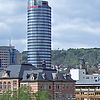
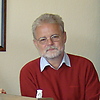
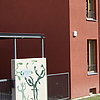
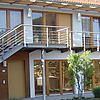
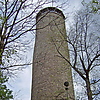
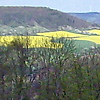
Where will our students live?
Frau Ruth R. has been a faithful participant in Goshens SST program for many years. Since 1999, she has been our primary contact in arranging host families for students in Jena. Joe met with Frau R. and her husband this week to begin the matching process of host families and students. Frau R. and thirteen other households will host our fifteen students this year.
Our host families are:
younger families, retired couples, single-adult householdswith or without children
lifelong Jena residents or have moved here from other parts of Germany (before or after the Wende
pastors, bookstore employees, doctors, other occupations
varying economic levels.
These pictures show some of the variety in what our students will call home for the coming weeks. Some students will find themselves living in very old dwellings, others in brand-new ones. Some will be in apartments in large complexes, others in smaller, multi-family structures. One will even live in a church.
Many, but not all, of these households have hosted Goshen students in the past. Whether or not another student has lived in the household, this years combinations of students and hosts will be newdifferent in what each learns from and with the other.
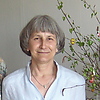
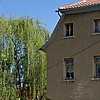
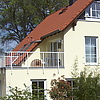
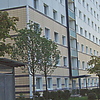
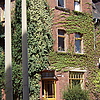
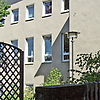
Thu, 3 May 2007Arrived safely
With the arrival in Jena of fifteen students from Goshen, via Chicago and Frankfurt where Joe had met them, the 2007 German SST unit began on Thursday May 3rd. The students emerged from the bus exhausted but not too tired to appreciate the humor of locking their luggage in a washroon/lavatory/Toilette in the Christliches Gymnasium (Christian High School) where they will have their German language instruction. After stowing their luggage, the group had its first lesson on how to use German public transportation by taking the Strassenbahn (Streetcar) to the center of the city. After a brief stroll through the streets of old Jena, the group settled down in the garden of Gasthaus Zur Noll, one of Jena's older, cozier and tastier establishments. (For a more complete description and history of the restaurant in German, visit www.zur-noll.de.) A "welcome" meal at Zur Noll has become an SST tradition, and the proprietors of the restaurant prepared a special menu for our students. This year's meal ended with an ice cream creation with which all were delighted and impressed. Most of the students were surprised to find how humngry they were and ate the German cuisine with relish. The food gave them enough energy to do a bit more wandering before climbing onto the Strassenbahn and heading back to the school. All were pleased when host families began to pick them up as soon as the group arrived at the high school. The warmth with which the families greeted their Goshen students helped alleviate the timidity that some felt about going home for the first time.
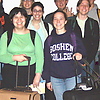
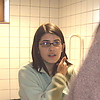
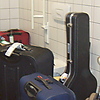
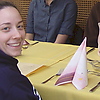
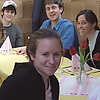
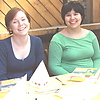
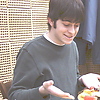
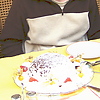
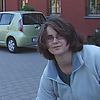
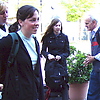
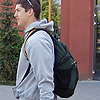
Fri, 11 May 2007 Our First Week: Classroom instruction
We have been in Jena for a week and have experienced the routine of SST. We meet in the mornings at the Christliches Gymnasium (Christian High School) for language instruction in two separate groups (sessions of 1.5-2.5 hours each). The theme for this first week has been learning German as a foreign language. We are now moving on to descriptions of our families and practice with comparative adjectives.
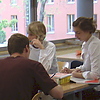
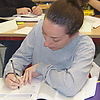
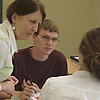
Our First Lecture and Field Trip
In the afternoons, we have lectures on topics such as the reunification of West and East Germany, field trips to Jena's institutions and social services, and group meetings to discuss our observations and insights. This week we heard a lecture (auf Deutsch) on the Friedliche (peaceful) Revolution given by Bernd Z. in which he described his personal experience of the dramatic changes that have taken place in the last 20 years and their effect on him and his family. Our field trip entailed a tour of the center of Jena focusing upon historical locations most of which are associated with its university (now called Friedrich Schiller University)that was founded in the 16th century. The tour ended with an ascent up the JenTower (Jenas 29 story modern office building) where we had a panoramic view of the city. Everyone enjoyed picking out his or her own home.
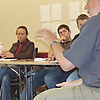
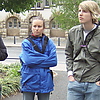
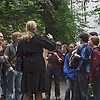
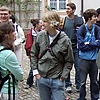
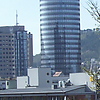
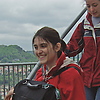
Our First Excursion
Each week we have an excursion to another city. Our first excursion was to Eisenach and Arnstadt. After arriving in Eisenach, we traveled up to the Wartburg, a castle built in the 11th century where Martin Luther hid after being excommunicated and where he translated the New Testament from Greek into German. We then went down to the town of Eisenach for lunch and visited the Bachhaus, a museum next to Johann Sebastian Bachs birthplace. We listened to a demonstration of instruments contemporary to those upon which Bach composed his works (with the assistance of a Goshen student at the hand worked bellows) and then wandered through a room that contained manuscripts, artifacts and very comfortable listening booths. After wandering briefly through Eisenach to see the half timbered house where Luther had studied as a boy, we traveled to Arnstadt, the city where Bach had been first employed as an organist. In the Church of St. Boniface, we listened to a concert that included the use of the Bach organ, an ornate baroque instrument, and several selections of Bachs work. We were polite and refrained from taking pictures during the concert itself.
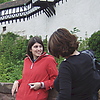
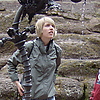
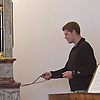
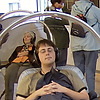
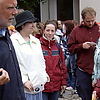
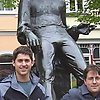
Group Meetings and Individual Activities
At least once a week, the whole group gets together at Joe and Jo-Ann's home to discuss the insights that we have gained in structured activities and individual investigations. Besides SST group activities, we have all been busy getting to know our host families. If our host families have nothing planned, students are welcomed to join Joe and Jo-Ann, their SST leaders, on their short excursions. Last Saturday, two students joined them to visit the Leuchtenburg, a castle a short train trip up the Saale River valley. We had a pleasant hike up to the Burg and spent a leisurely hour exploring its rooms and collections that included an exhibit on the history of the local porcelain industry. No doubt, all will agree that we have gotten off to an excellent start.
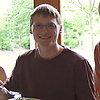
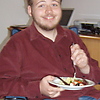
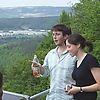
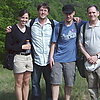
Wed, 16 May 2007Excursion to Naumburg
Over the weekend, students traveled with families to national parks and church festivals and local sites or stayed in Jena to participate in family gatherings of various sorts. On Tuesday, we had our second group excursion. We traveled by train to Naumburg, a city that was once part of the Hanseatic League and had experienced significant prosperity during the late Medieval and early Renaissance period. The city was not bombed at the end of WWII, so much of its old city center remains intact. It is now undergoing restoration work to deal with the wear of time any neglect that buildings and monuments suffered during the socialist era. Despite warnings that German weather is changeable, a number of students found themselves without umbrellas or jackets during our rather wet wanderings. Umbrellas were shared and everyone was grateful that our tour leader, Wolfgang B., found covered doorways and canopies under which students could listen to what he had to say in comfort. Wolfgang described the unique gate to the old city that had a blind second door so that unwelcome visitors to the city could be trapped before they actually entered the city. He showed us the Rathaus (city hall), a Renaissance building with an elaborate Renaissance door, that is evidence of the citys former prosperity. Inside St. Wenceslas Church, Wolfgang pointed to how the Gothic building had been transformed by the addition of a Baroque altar and organ. Students have just completed an investigation on art and architecture that prepared them to understand exactly to what he referred. [Observations: (1) The ubiquity of digital cameras makes it difficult to take a photograph in which students are not taking photographs. (2) On German SST, one must remember to do neck muscle relaxation exercises after an excursion.] We then headed back into the rain to the St. Peter and St. Paul Cathedral, another Gothic church that is significant for many reasons, chief of which is the fact that it still has its two Letttners (rood or chancel screens) that divide the nave of the church from the choir. During the Reformation and Counter Reformation, most Lettners were removed. Students also appreciated the work of the Master of Naumburg, a 13th century artist whose work is as realistic as that of Renaissance artists who lived two centuries later. Unfortunately, we were not allowed to take pictures inside the church without paying a fee. If you are interested in seeing what we saw, visit the following web site: http://www.holycross.edu/departments/visarts/vraguin/nambrg.htm. Of course, as soon as students had a chance to purchase umbrellas, the rain stopped. Several students took advantage of the relatively empty train to relax after the days exertions.
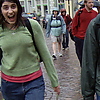
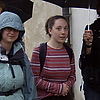
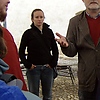
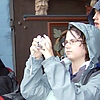
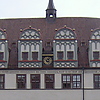
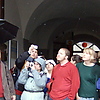
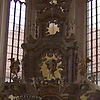
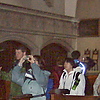
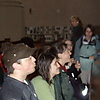
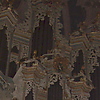
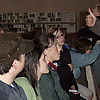
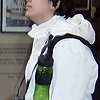
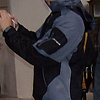
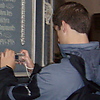
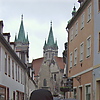
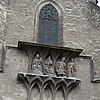
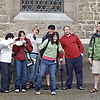
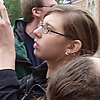
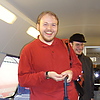
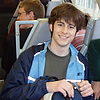
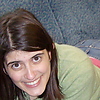
Wed, 23 May 2007SST at Play
Our focus of this week is Jenas economy and social realities. We visited a Daycare/Kindergarten as a way of getting a window into many issues: German educational priorities, the differences between attitudes towards women, work and child care in the former East and West Germanys, ongoing adjustments to unification, population decline, and the centrality of the question of adequate day care in the last federal election. Students enjoyed the hospitality with which they were greeted, playing with the children and wandering through the many theme rooms of the facility. A reporter from a local newspaper had been notified that our group would be visiting the Kindergarten and a lovely piece with a group picture appeared in the paper this morning. (The story did not appear in their web edition.) We have included several pictures at the end of this blog that add a few glimpses into SST in Germany including an inventive way of keeping cool.
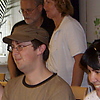
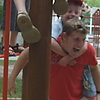
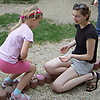
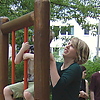
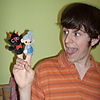
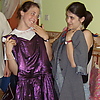
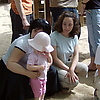
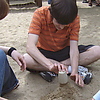
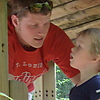
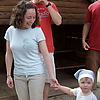
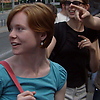
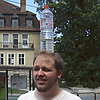
Thu, 24 May 2007Jena science and industry
[www.schott.com...] -- Hardly a free moment this week in Jena. We crammed in some extra hours of language instruction quick before the extended Pentecost holiday weekend, had two lectures/discussions with Jenakolleg partners on recent German history and current events, and two excursions. This afternoon in a hot afternoon sun that reminded us that some of our brothers and sisters are in the Caribbean, we trudged up to the Schott Glass Factory. Laura R.s host mother, director of the company museum, gave us a good introduction to the history of this Jena-born company. She described its intellectual and physical dismantling following World War II, and the reunification of operations after 1989. The Schott family villa on the factory grounds provides a general overview of family and organizational history. Another building traces the history of glassmaking, development of optical glass, heat-resistant glass and other products developed by Schott in more than a century of existence. Well wind down the week tomorrow, take a breather, and then head for Berlin on Tuesday.
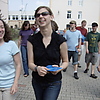
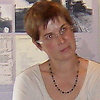
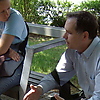
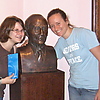
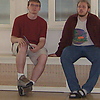
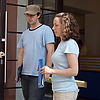
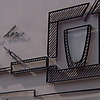
Sun, 3 Jun 2007Berlin Trip--Part I
Most SST groups spend their first weeks in the host countrys capital. In Germany, we consider ourselves fortunate to spend three days in the new capital cityBerlin.
On Tuesday (May 29), we assembled in the rain at the train station in Jena. After a smooth and speedy ride on a sleek Intercity-Express (ICE) we arrived at Berlins new glass-and-steel Hauptbahnhof (main train station). There we were met by a tour guide and bus who whisked us off on a three-hour introductory tour of some of the sights and neighborhoods of Berlin before dropping us off at a youth hostel at the northwest edge of the city. We dumped our belongings and took a 30-minute bus & subway ride back into one of Berlins centers, Friedrichstrasse.
A ferocious thunderstorm kept us underground at first. (The picture of Adam and the water pouring down the subway steps gives you but a hint. More impressive at the time was seeing the water streaming on to the high-voltage subway rails and leaking through light fixtures inside the station!) Soon the storm lifted enough to allow us to emerge above ground. Jenakollegs Wolfgang B. then began marching us through the first of three grand walking tours of different sections of the city.
The late 20th-century glass cupola atop the German Reichstag (Parliament Building) was the final destination of our first day. Open to the sky above, visitors have symbolic oversight of proceedings in the chambers below and can still view scars of World War II on the original structure. As darkness fell, we wandered through the Brandenburg Gate on our way back to the subway, and our hostel.
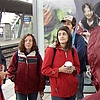
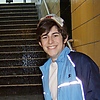
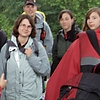
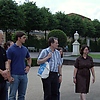
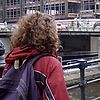
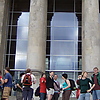
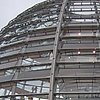
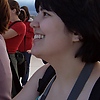
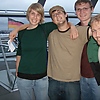
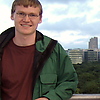
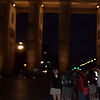
Berlin Trip--Part II
Part of our objective in Berlin was to begin forming an understanding of the historical, cultural, and symbolic importance of the citys many layers. In some places the recent past is being obliterated to resurrect 18th-century structures first built for rich, powerful rulers. Massive public structures from the 19th century bear testimony to intellectual and imperial strength. World War IIs destruction of large parts of Berlin is still visible in many places. It was instructive to consider the differences between what was built in those urban holes in eastern and western Berlin before 1989. Since 1989, additional spaces have been filled by new palaces designed to feed consumer desires.
Wednesdays morning walking tour included, among many other things, the graves of several people Jo-Ann insists we need to know to understand German culture. It ended with an ecumenical church service at the massive Berlin Cathedral during which Berlins Protestant bishop and Catholic cardinal shared duties. In the afternoon we fanned out across the city on our ownthe new Jewish Museum, an evening opera performance (Verdis Don Carlo), and a exploring Berlins diverse Kreuzberg neighborhood were some of the activities students took in before traveling back to our hostel.
By Thursday we were used to Wolfgangs quick pace and took in the ultramodern structures of Potsdamer Platz. Only a few short sections of the notorious Berlin Wall remain standingwe posed in front of one such sectionbut elsewhere one can now follow a subtle cobblestone reminder of where the wall once ran. In the afternoon we chose among three of Berlins grand museumsthe Pergamon (with its Near and Middle Eastern antiquitiesgates mentioned in the Old Testament, an altar named in the Book of Revelation), the German Historical Museum, and the National Gallery. At the end of the day we traversed central Berlin one last time via public double-decker bus on our way back to the train station and home.
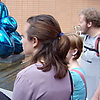
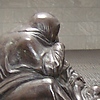
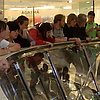
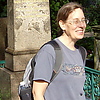
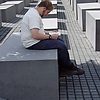
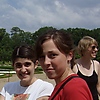
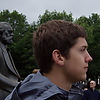
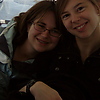
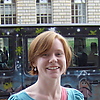
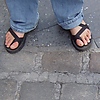
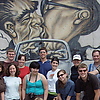
Wed, 6 Jun 2007Buchenwald
[www.buchenwald.de...] -- We prepared for our visit to Buchenwald by reading Eli Wiesels Night, an autobiographical account of his incarceration in Auschwitz and the death march to Buchenwald where his father died and he was liberated when the S.S. guards fled from the advancing American army.
Between 1937 and 1945, 56,000 people deemed undesirable by the National Socialist Party were murdered here. Wiesels story and the pictures painted in words by Bernd Z helped us fill in the empty spaces once occupied by cramped barracks.
These photographs capture the intent expression of students as they strove to comprehend the horror and to acknowledge and respect those who suffered and then died or survived. Other spots--the crematorium where bodies were reduced to ashes to be sold for fertilizer and rooms where the innocent prisoners were tortured and executedwe remember with silence and prayer rather than by posting photographs.
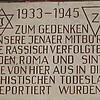
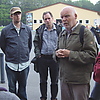
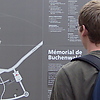
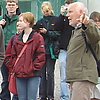
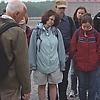
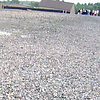
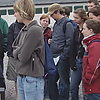
Weimar
[www.uni-leipzig.de...] -- Weimar is a city the name of which is synonymous with Goethe and Schiller, Germanys most beloved poet philosophers.
Our tour of the city took us through the park in which Goethe met the love of his life, past the homes in which the poets resided, the palaces in which their work was performed, the places and memorial their work inspired, and their final resting place in the Ducal Vault in the citys cemetery.
GC students have come to appreciate the romantic spirit of Goethe and Schiller, and many of the photos capture them in quiet contemplation. Some celebrated Goethes love of humanity by taking their place on a monument dedicated in 2000 to Goethe and his efforts at cross-cultural communication between the orient and the occident. We all gathered under the monument to the two poets collegial friendship, the kind of friendship that we have come to share and cherish.
Our tour also included a visit to the elder Lucas Cranachs Altar painting in the St. Peter and Paul Church. Cranach painted this, his last work, as a personal testament to his protestant faith.
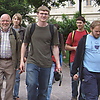
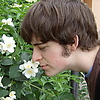
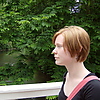
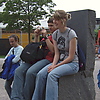
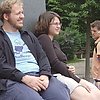
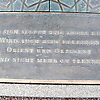
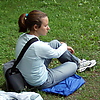
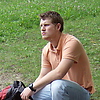
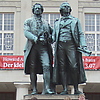
Thu, 14 Jun 2007Erfurt
[en.wikipedia.org...] -- For our last excursion as a group, we traveled to Erfurt, the capital city of Th�ringen. Erfurt was not targeted for bombing by the Allied forces during WWII; consequently, many Medieval and Renaissance buildings are still standing and in use. Of particular note is the Kr�merbr�cke, a bridge dating to 1325 that crosses the Gera river upon which homes and shops dating to the Middle Ages still stand. We also visited the Augustinerkloster where Martin Luther became a monk and the Dom, also known as the Marienkirche, a first rate Gothic cathedral.
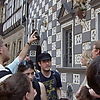
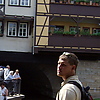
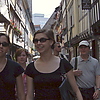
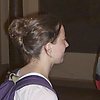
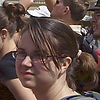
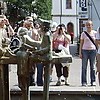
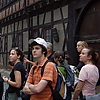
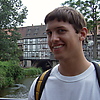
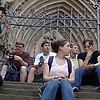
Ice Cream and an Exam
Students wrote their German language exam today. As a reward for their hard work and as a farewell before the students head out on service, our generous associates at Jenakolleg treated them to ice cream. Now is your chance to determine how well you know your children and friends. See if you can identify who ordered what. The picture answer key is in the next blog entry.
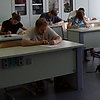
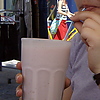
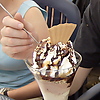
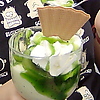
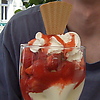
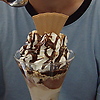
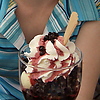
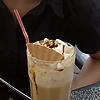
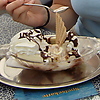
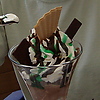
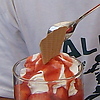
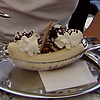
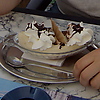
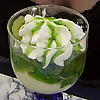
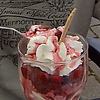
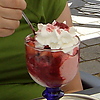
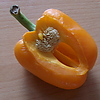
Your Exam Results
If you have not read the previous entry, "Ice Cream and an Exam," stop! Go to the previous entry and test your knowledge of your child and friends.
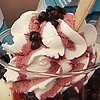
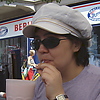
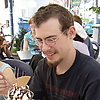
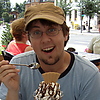
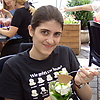
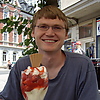
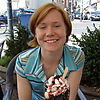
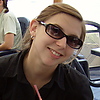
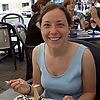
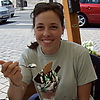
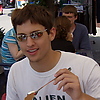
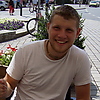
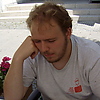
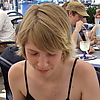
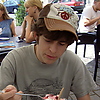
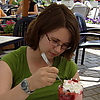
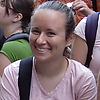
Sun, 17 Jun 2007Fond farewell
On Friday afternoon the SSTers met at Lutherhaus, a congregation that includes a number of our host families. Many hands went to work: crushing tortilla chips & matzo (no soda crackers in Jena stores ...), frying ground beef, slicing lettuces, peppers, carrots, etc., etc. Our goal: treat our families to an authentic northern Indiana haystacks meal. We sliced, diced, fried and arranged the food, folded origami cranes & napkins, and then practiced our program.
By the time our guests arrived, almost everything was ready. The evening passed quickly as we gathered with our host families, teachers and Jenakolleg. After eating, and before continuing our fellowship, students sang a few hymns, danced to Beccas fiddle, and recited a doggerel alphabet (auf Deutsch) incorporating words that became familiar to us here. Families and students alike seemed ready to repeat the good experiences of the past six weeks! Jenakollegs Kerstin P. offered us solace and blessing in a poem by Jenas Klaus-Peter Hertzsch Departure: ... And what has passed, has not disappeared; it rests securely in Gods eternal care ..."
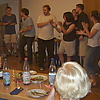
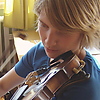
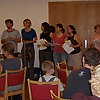
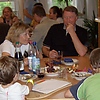
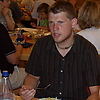
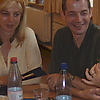
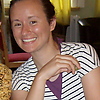
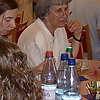
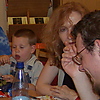
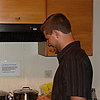
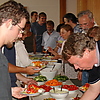
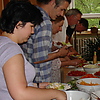
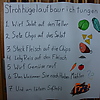
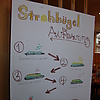
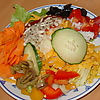
Family portraits
Here are family portraits of most of those in attendance at our farewell party (courtesy of Erin B.) Apologies to Jessica & Abri and their host families-- not represented in this set due to a technical snafu!
Note:On Monday morning students head out singly and in pairs to ten different service locations. Due to travel schedules, there will not be another blog update until after the beginning of July.
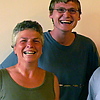
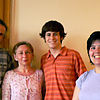
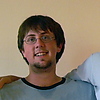
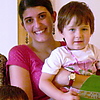
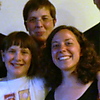
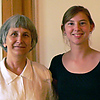
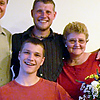
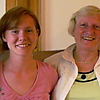
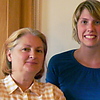
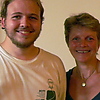
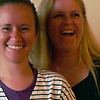
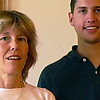
Mon, 2 Jul 2007Service in Guben - Nate & Jeff
[www.heilsarmee-ost.de...] -- Jeff & Nate are working with the Salvation Army in Guben, located on the German-Polish border. The Salvation Army owns a good-sized former kindergarten facility in the Socialist era subdivision on a hill at the edge of town. Jeff & Nate join Frau M. and Frau O. there in providing after-school activities and economical evening meals for children up to age 14. Before 1990, the city's population was about 60,000, but has now dropped to a third of that. The local unemployment rate is high and alcohol and domestic abuse all too common.
Joe paid a quick visit to them a week into their assignment and found that they had already constructed soccer goals and were busily assembling a new swing set. Co-workers and children alike are enjoying the energetic enthusiasm Nate & Jeff bring with them to Guben.
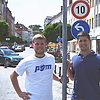
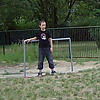
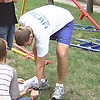
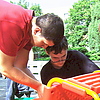
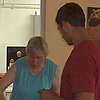
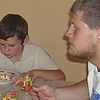
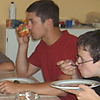
Tue, 3 Jul 2007Service in Selbitz - Emily
[www.christusbruderschaft.de...] -- Emily is working with Christusbruderschaft, a religious community founded in 1949. She lives at the main headquarters of this group, located outside the small town of Selbitz in northern Bavaria. The town is just a few kilometers away from what used to be the border dividing East and West Germany. This Lutheran community follows evangelical principles of poverty, chastity, and obedience. Daily life includes regular periods of prayer, worship, and work. Emily works in the extensive gardens (vegetable & flower) of the community and assists in the kitchen. The communitys noon meal that day included basil and strawberries harvested by Emily.
We visited Emily on a very rainy day. Between downpours, we managed to tour the main house from cellar to attic. (Emilys room under the eaves benefits from the fragrance of herbs drying nearby for the communitys tasty teas). Alas it was too wet to venture along her favorite paths in the Upper Franconian forest that encircles the communitys property. Before leaving, we toured the retirement and healthcare facility. A guest house and a publishing house are also part of the communitys center at Selbitz.
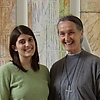
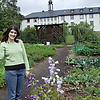
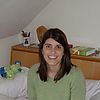
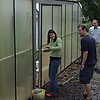
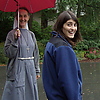
Service in Magdeburg - Adam
[www.stejh.de...] -- Adam is working at a trilingual child-care center/kindergarten in Magdeburg. Located on the Elbe River, Magdeburg is the provincial capital of Sachsen-Anhalt. We met Adam Sunday evening in front of the citys massive Gothic cathedral. We then walked around the nearby neighborhood that includes examples of far more recent architecture including a mixed residential-commercial structure designed by Austrian artist-architect Friedensreich Hundertwasser.
On Monday morning we went to Neu-Olvenstedt, the outlying district where Adam lives and works. The Protestant foundation operating this center also runs about a dozen others in the region of Magdeburg. The Neu-Olvenstedt center is the only trilingual (German-French-English) facility. Children come from all over the city to attend. Most of Adams work so far has been with the youngest group (ages 1-3) in the German-English section. He reports quickly catching on to which of the toddlers will have trouble with naptime. Adam also floats among several other units/age groups in the facility.
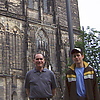
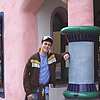
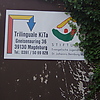
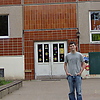
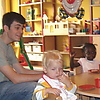
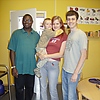
Service in Derenburg - Erin
Erin is working at the St. Katharinen senior health care center in Derenburg, a small town just north of the Harz Mountains. Built in the 1890s, the facility has been fully renovated in the past decade. Erin assists with feeding residents and helps the staff with games and group activities. Throughout the majority of the life spans of the fifty residents, Americans were the enemy. Encountering an American is a relatively novel and welcome experience for them. Co-workers report that residents enjoy Erins big smile and the time she takes to listen to residents stories (even if repeated a third or fourth time!)
After touring St. Katharinen, we went to one of Derenburgs few restaurantsa recently-restored early 20th-century villa that during the 1980s housed Vietnamese guest workers at a local factory. A peek at Derenburgs glass factory and a jaunt to the nearby city of Wernigerode completed our visit with Erin.
[P.S. St. Katharinen does not have a website. Our next blog update will likely not occur before July 12.]
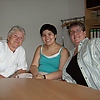
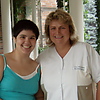
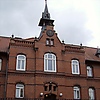
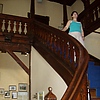
Mon, 9 Jul 2007Service in Neufrankenroda Jesse & Haniel
[www.siloah-hof.de...] -- Jesse & Haniel are working with Siloah Hof in Neufrankenroda, not far from the city of Gotha. Among other things, this diverse Christian community engages in organic farming and runs a camp.
We arrived in time for a cup of coffee just before the communitys regular noon prayer in the crypt (see webpage). Our students do a wide range of tasks from splitting wood to setting up equipment for groups using the camp. Animals from zebu cattle to geese provide additional work. In free time Haniel & Jesse get to experiment with more relaxing activities such as making pottery and learning to play the bagpipe.
An old construction trailer parked out behind one of the barns is their home for several more weeks. It was comforting that even at the end of the earth (as Siloah community members enjoy calling their property), one can get directions to Goshen.
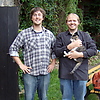
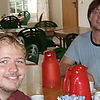
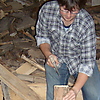
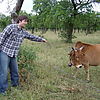
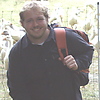
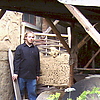
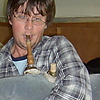
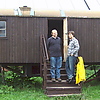
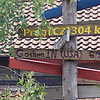
Thu, 12 Jul 2007Service in Allmenhausen, CHUBA Justin
[www.chuba.de...] -- Justin is working with the CVJM (the German YMCA) at a center called CHUBA, housed in a 17th-century half-timbered building. CHUBA provides Christian outreach to children and youth in an area where a typical Sunday morning may have only 5 people show up at the village church. Their building is also used for for church-related retreats and international guests, most recently visitors from Tanzania and India. He works with other volunteers from Slovakia with the day to day operations of the building & grounds, readying the rooms for new visitors, preparing and cleaning up from meals and organizing programs for visiting and area youth. Among CHUBA traditions are lawn canoe races. Justin was on the winning team last week but we were not there to get pictures. We do have pictures of Justin with several of his co-workers, the director of CHUBA and with his direct supervisor.
Allmenhausen is a very small village, so we continued our visit in M�hlhausen, a city with a nearly intact medieval wall. Joe and Justin are standing in the doorway to the Marienkirche, a church linked with the name Johann Sebastian Bach and Thomas M�ntzer. Above them stand the wise and the foolish bridesmaids from Matthew 25:1-13. We also stopped to take pictures at nearby Niederdorla, the geographic center of Germany.
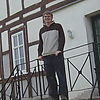
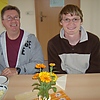
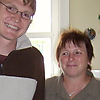
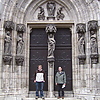
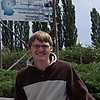
Service in Volkenroda Abri & Janell
[www.kloster-volkenroda.de...] -- Janell & Abri are working at Kloster Volkenroda,a retreat center run by a Christian community known as the Jesus-Bruderschaft. A medieval Cistercian abbey, Volkenroda was destroyed during the Peasants War in 1525. In the last 15 years, the Jesus-Bruderschaft has worked to restore remaining parts of the original buildings and added others.
Under the friendly direction of Elsa, both students work in the kitchen and getting rooms cleaned and ready for the many guests that come for retreats. They feel a sense of joy in participating in the operation of this center which without volunteers would not be possible. Abri & Janell share a room, currently featuring flowers mysteriously delivered from the Dominican Republic. One of the buildings at Kloster Volkenroda, the Christus Pavillon, was designed for Expo 2002 in Hannover and reconstructed on its present site. The walls are double-paned glass filled with objects of symbolic value. Our duo chose one of their favorite panels in front of which to pose.
Janell and Abri are working in what they claim to be the most beautiful location in Germanybe sure to follow the web link provided for pictures better than those we took. [See also http://www.evangelische-zisterzienser-erben.de/volkenroda.htm and http://en.wikipedia.org/wiki/Volkenroda_Abbey]
We apologize for the late posting of this entry--mistakenly entered on a different blog page!
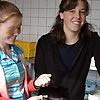
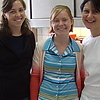
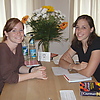
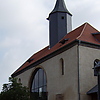
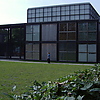
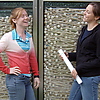
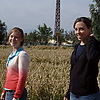
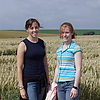
Mon, 16 Jul 2007Service in Bad Sulza Camry & Laura
[www.sophien-klinik.de...] -- Camry & Laura are doing their service at the Sophienklinik, a rehabilitation clinic in Bad Sulza, north of Jena. Founded in the 19th-century by deaconesses from Weimar, it continues to operate as a Christian organization under the motto Healing Water, Healing Word. The clinic specializes in providing rehabilitation for a variety of childhood developmental conditions as well as for adults with respiratory, cardiac or physical mobility problems. Clinic management emphasizes personal care and friendly interaction with patients and guests.
Laura is working with the Kinderclub (childrens club). She assists with daily activities for children at the clinicsome here as patients, others accompanying parents while they undergo rehabilitation. Camry has made the clinic kitchen her specialityhelping in food prep and, of course, dishwashing. The duo shares cozy quarters in a room in one of the original buildings of the clinic. Camry gave us a tour of a "Biodach" (green roof), used on several of the clinic's buildings. (See the weblink for a better idea of the overall facilities.) In their free time, Laura & Camry enjoy heading out on foot or by bike to explore the small town of Bad Sulza and surrounding countryside.
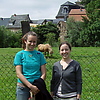
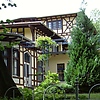
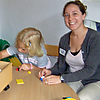
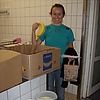
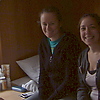
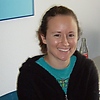
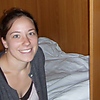
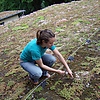
Service in Bad Klosterlausnitz Abby
[www.fachklinik-klosterwald.de...] -- Abby is working at the Fachklinik Klosterwald, a Methodist-affiliated addiction clinic in the town of Bad Klosterlausnitz, east of Jena. The well-staffed facility offers therapy to men and women with a variety of addictions. Among Abbys co-workers is another U.S. volunteer who recently graduated from Earlham College.
During the first days of service, Abby got to see various parts of the operationtherapy, kitchen, patient transport, yard maintenance. When a member of the kitchen staff suffered an unfortunate accident, Abby found herself needed full-time there. Though the tasks are sometimes tedious, she enjoys the camaraderie of the staff. Bad Klosterlausnitz is a small town and Abby is exploring it thoroughly. While working on her final project, she has also become friendly with the town librarianoverjoyed to help her obtain useful materials. She also spent one evening visiting with members of the Bruderhof (Society of Brothers) who established a household here several years ago. We met several of its members from England and Paraguay when we arrived by train.
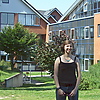
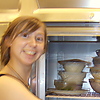
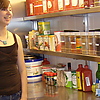
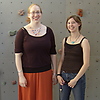
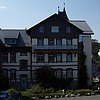
Service in Z�then Jessica & Becca
[www.schullandheim-plank.de...] -- Jessica & Becca are hard at work at the Schullandheim in Z�then, a private camp and equestrian center about 25 km north of Jena. Located in what in Socialist days was the main horsebreeding facility in Th�ringen, the facility now caters to school groups and others looking for short-term nature camps or equestrian training.
Becca & Jessicas were fortunate (?) enough to arrive in time to participate in the annual stall cleaning. Since then, they have spent many hours helping with the feeding and care of the animal population of the Schullandheim. When school groups arrive, they also help with activities such as pony rides. In addition to horses and ponies, the Schullandheim maintains an extensive menagerie of common and uncommon animals. Jessica & Becca have found llamas and goats friendlier in general than emus. The Wollschweine (woolly hogs) Jo-Ann and Joe remember from their 1999 visit to Z�then were seeking refuge in dark corners from a current heat wave so we have no pictures of them. Click on Unsere Tiere (our animals) for a peak at some of the other residents at Z�then.
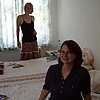
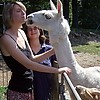
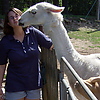
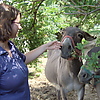
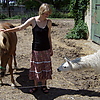
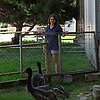
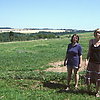
Service in Guben revisited Jeff & Nate
[www.heilsarmee-ost.de...] -- Jo-Ann missed out on the earlier visit to Guben, so we went to the end-of-school celebration there last week. Here are a few more pictures of Nate & Jeff with the neighborhood children and Salvation Army co-workers. (See the Monday, July 2 posting for more information.)
With our round of service visits complete, this may be our final posting to the blog. Students are now entering their final two weeks at service locations and working on final projects. They return to Jena on July 27 for a few days together before flying home early on July 31. (If the whirlwind of closing activities allows time, we may make one last post at the end of July.) Our students have appreciated the support they have received from family and friends throughout their time here in Germany!
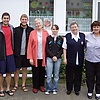
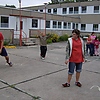
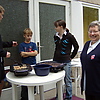
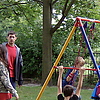
Sun, 29 Jul 2007Back in Jena/closing activities
All students returned safely to Jena on Friday, July 27. On Saturday, we all gathered for a marathon sharing of service experiences. Students talked about memorable individuals, moments of triumph and difficult moments. We identified "handprints" (things that we thought we would carry with us) and "footprints" (things that we thought we may have left with those we encountered here). Jo-Ann & Joe distributed light-hearted awards to each student tied to characteristics or memorable incidents related to individuals in the group.
Students also presented their semester projects. A detailed map was the anchor for an in-depth description of the multiple activities hosted by one location. A "SWOT analysis" (Strengths, Weaknesses, Opportunities, Threats) provided insights into the success and challenges of a Christian clinic. A communication major teamed up with an art major to describe and depict the variety of religious experiences in one community and attitudes toward art in the church. Observations of land use in Germany and an investigation into the nature and collaborations of German political parties were springboards for reflection on significant cultural differences. Among other projects: Photographs of elderly people with accompanying biographical information, design influences, local history, German colloquial sayings, translation & commentary of a medieval tale.
In the afternoon we spent several more hours getting reacquainted over a tasty meal in a nearby Bosnian restaurant. Then it was back to our host families for a few final hours. We will meet Monday afternoon again for some reflection on returning home. Late Monday evening we board a bus for the ride to Frankfurt, boarding the plane home early Tuesday morning. See you back home!
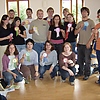
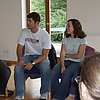
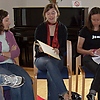
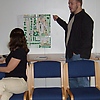
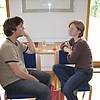
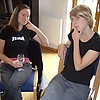
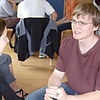
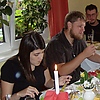
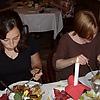
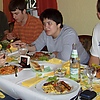

International Education Office
Kevin Koch
kevinak@goshen.edu
+1 (574) 535-7346












































































































































































































































































![]()